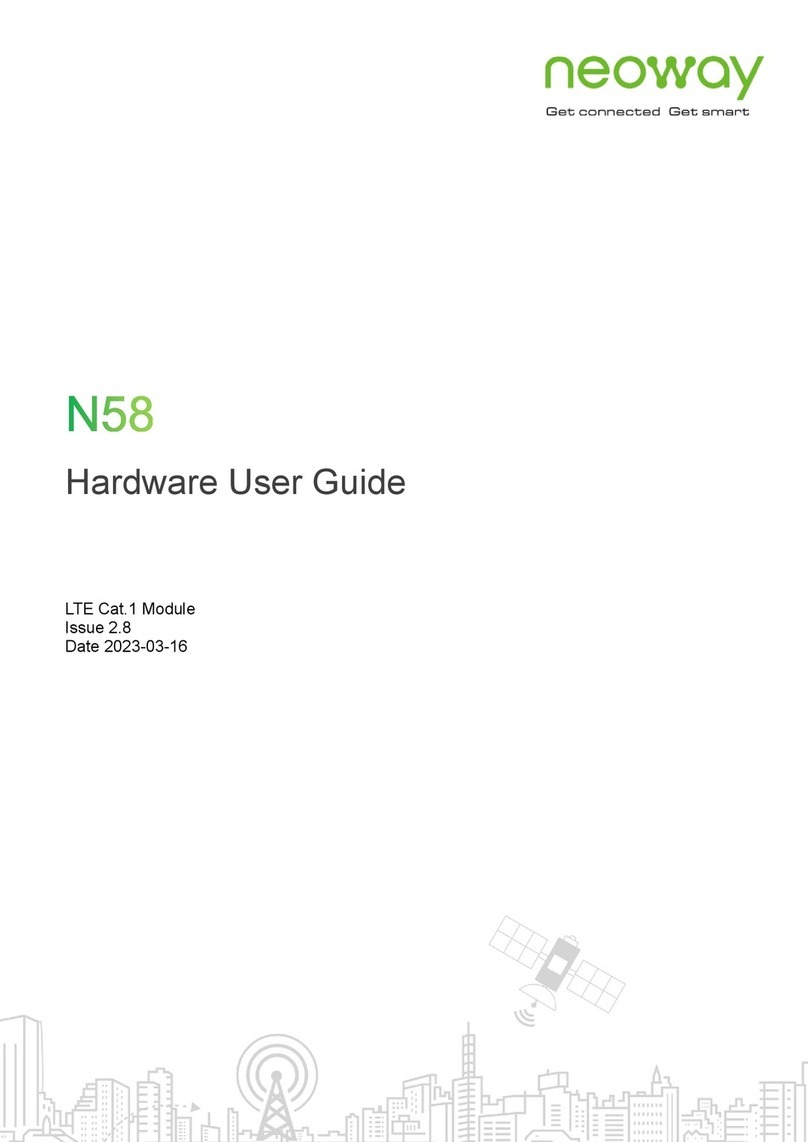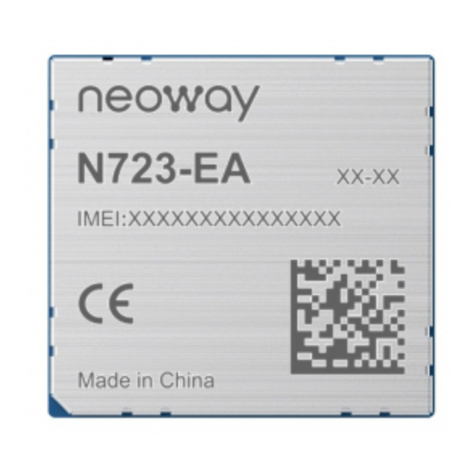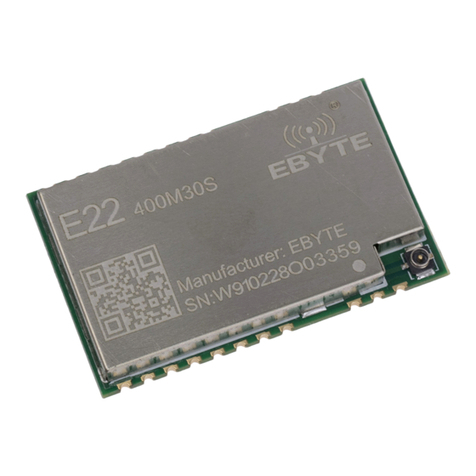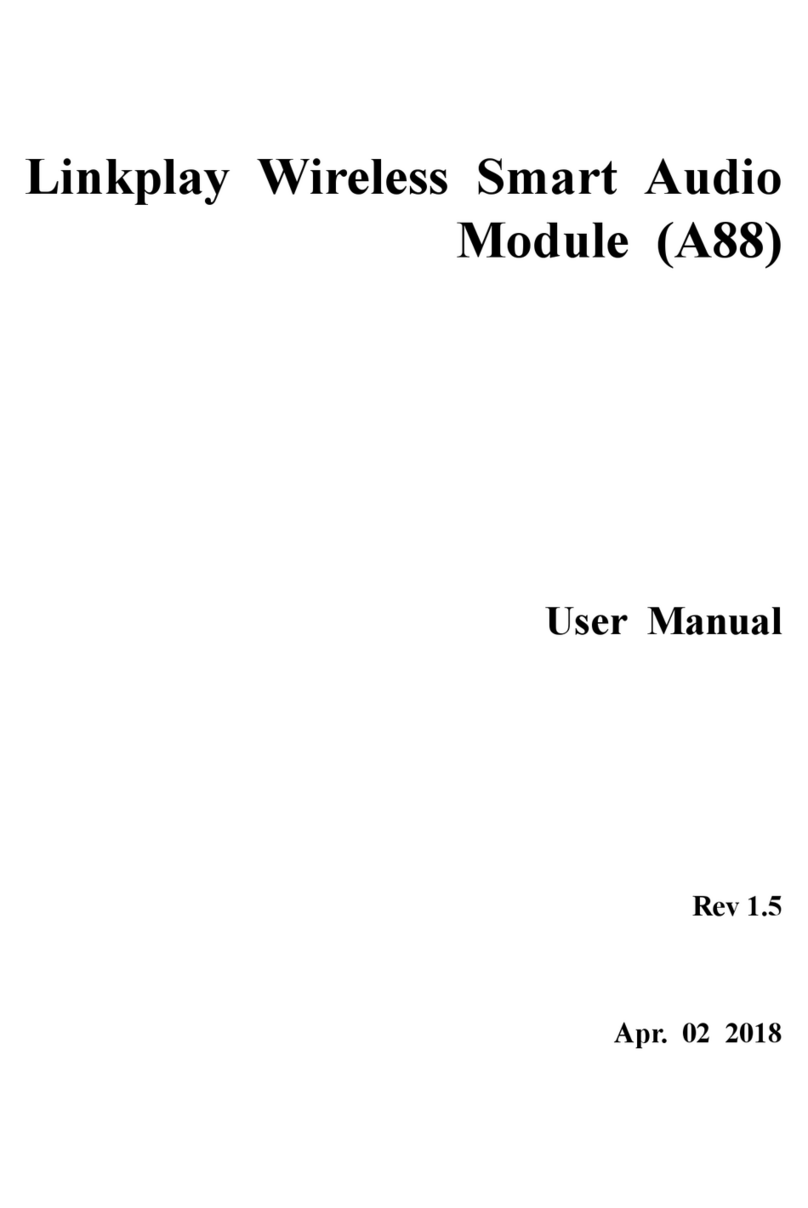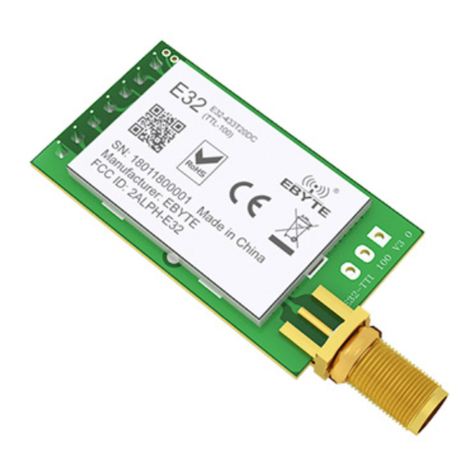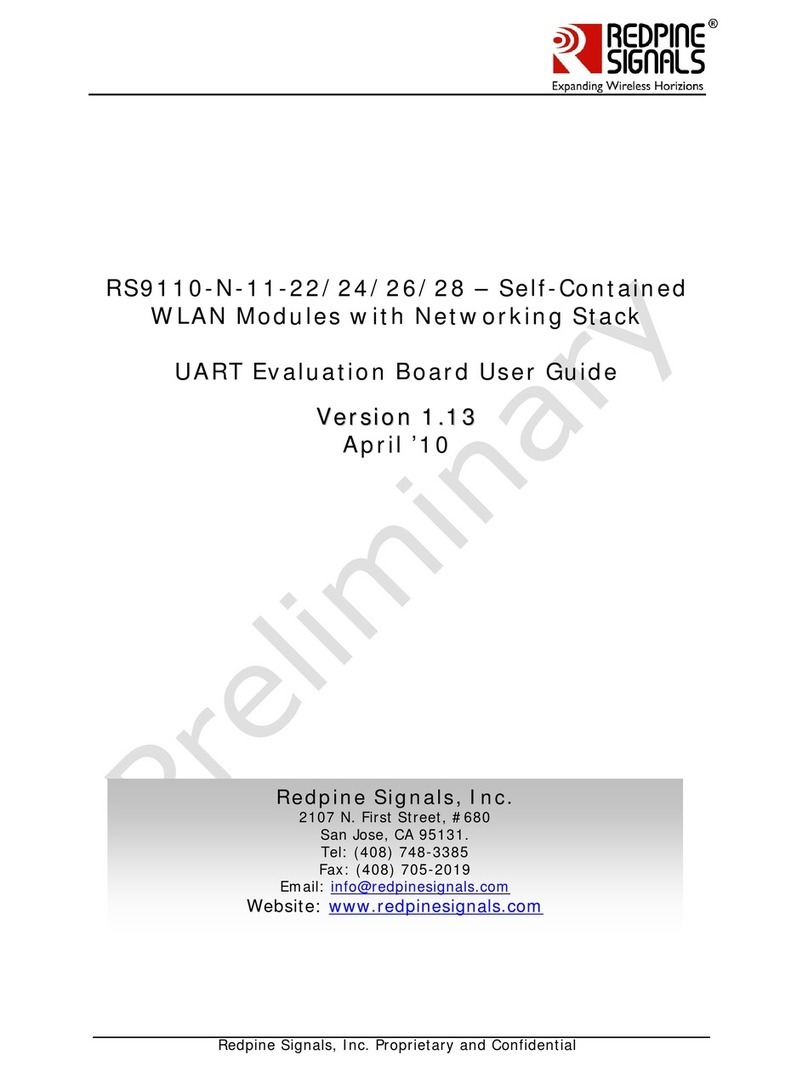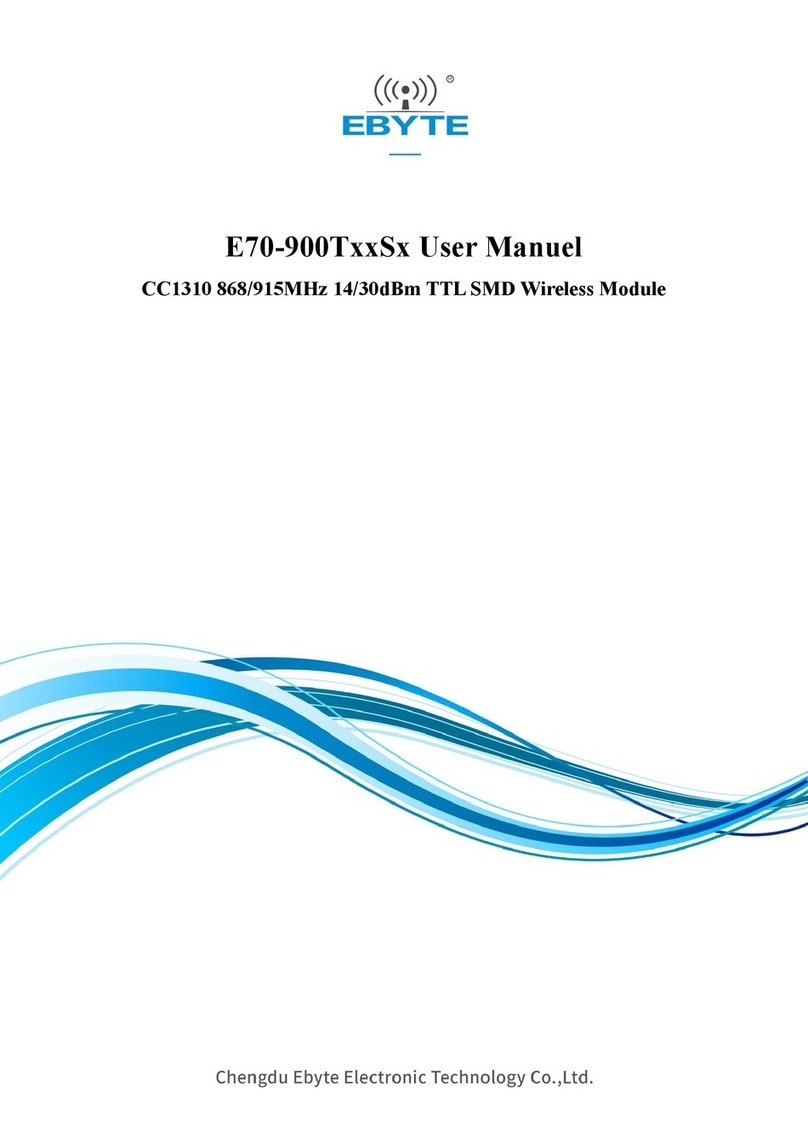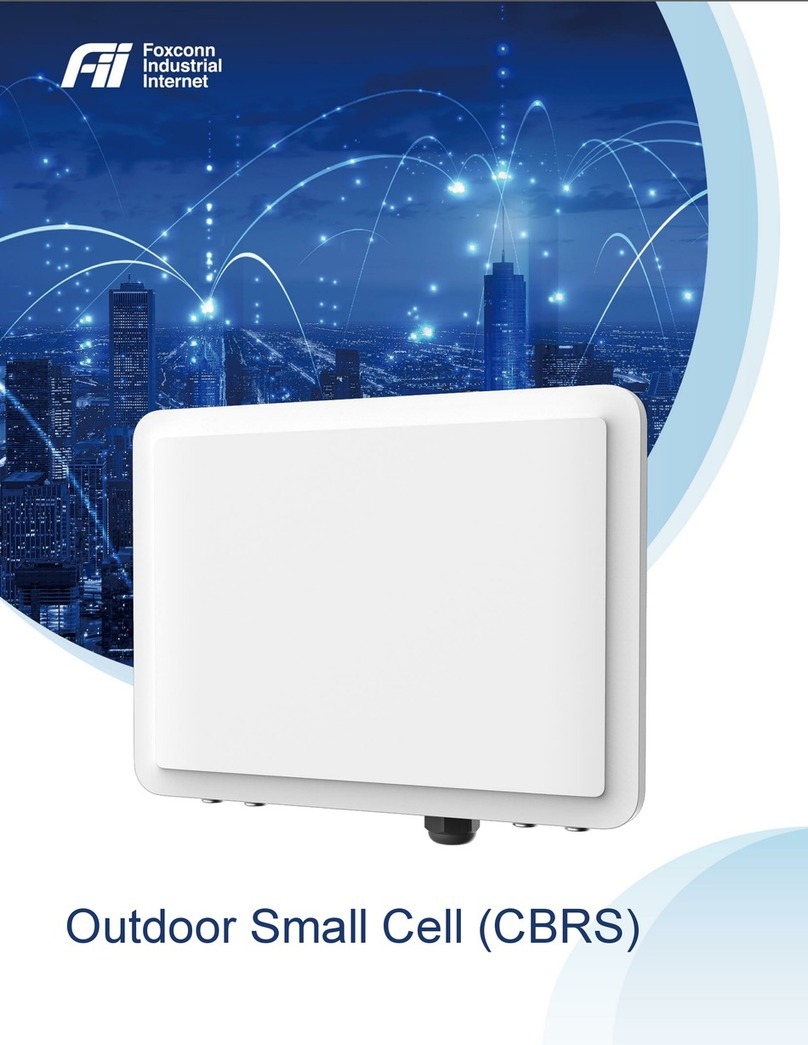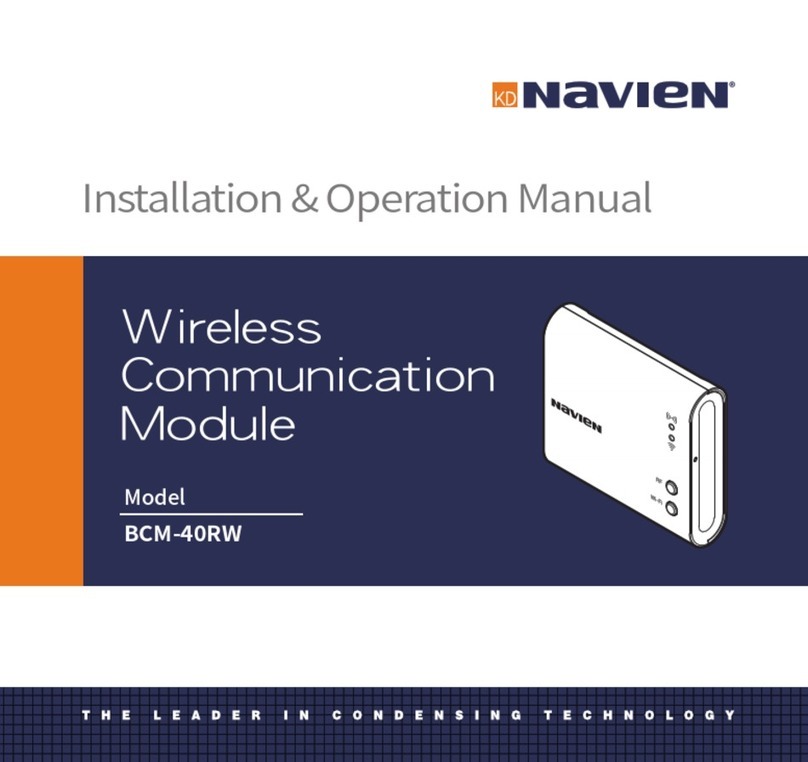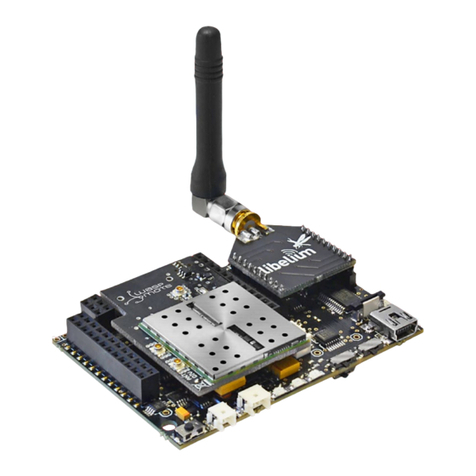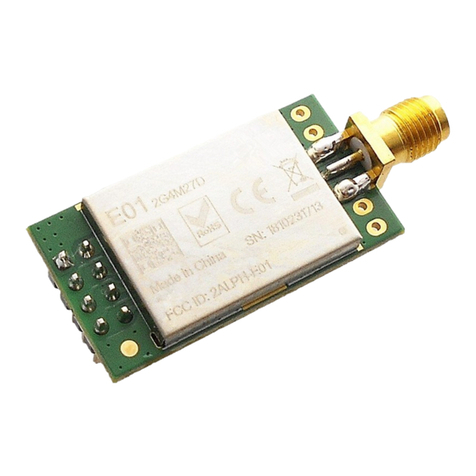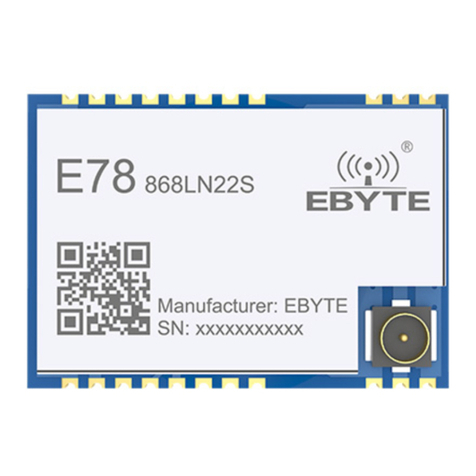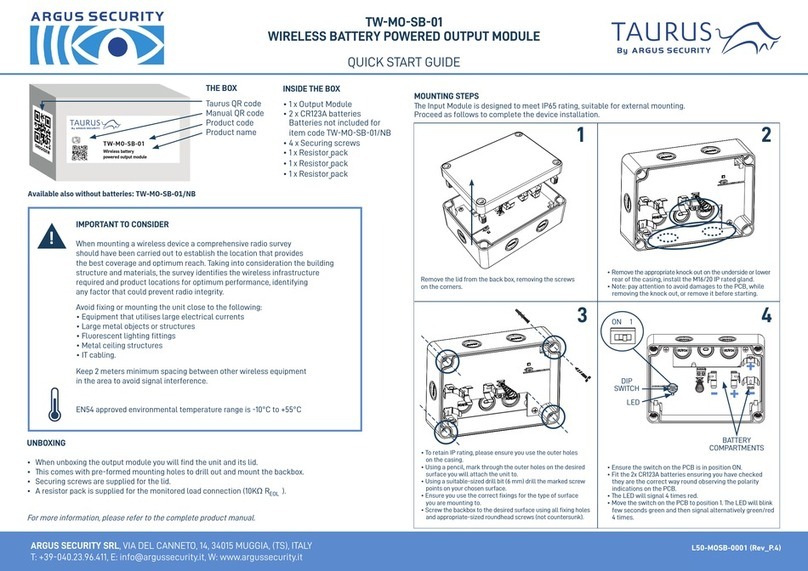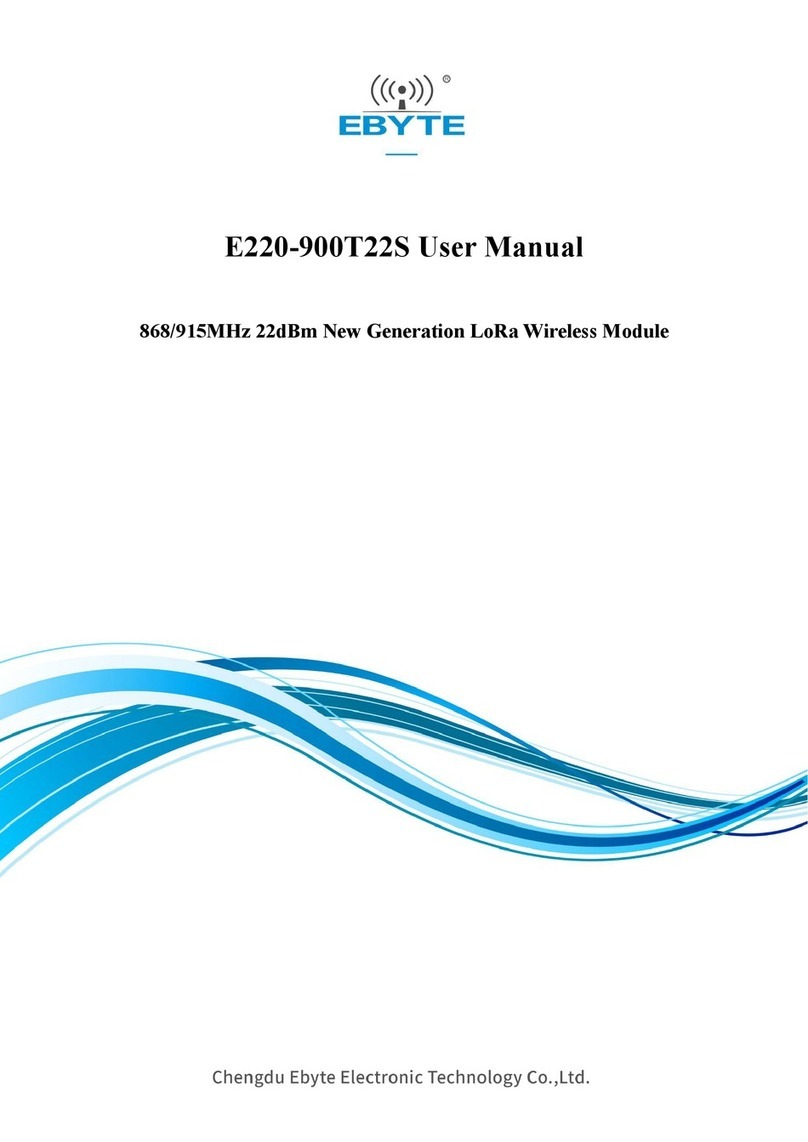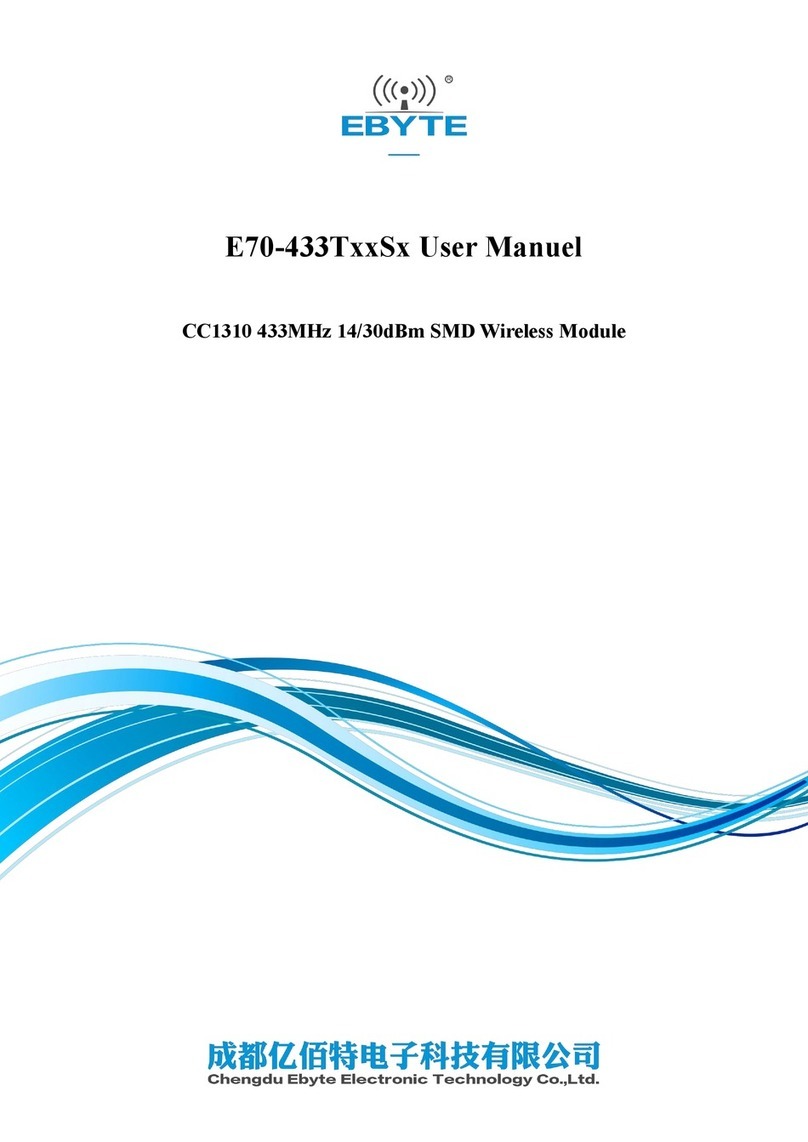Neoway N77 Installation manual

Hardware User Guide
Issue 1.0 Date 2021-02-01

N77 Hardware User Guide
Copyright
Copyright © Neoway Technology Co., Ltd.
ii
Copyright © Neoway Technology Co., Ltd 2021. All rights reserved.
No part of thisdocument may bereproduced or transmitted in any form orby any means withoutprior written
consent of Neoway Technology Co., Ltd.
is the trademark of Neoway Technology Co., Ltd.
All other trademarks and trade names mentioned in this document are the property of their respective
holders.
Notice
This document provides guide for users to use N77.
This document is intended for system engineers (SEs), development engineers, and test engineers.
THIS GUIDE PROVIDES INSTRUCTIONS FOR CUSTOMERS TO DESIGN THEIR APPLICATIONS.
PLEASE FOLLOW THE RULES AND PARAMETERS IN THIS GUIDE TO DESIGN AND COMMISSION.
NEOWAY WILL NOT TAKE ANY RESPONSIBILITY OF BODILY HURT OR ASSET LOSS CAUSED BY
IMPROPER OPERATIONS.
THE INFORMATION IN THIS DOCUMENT IS SUBJECT TO CHANGE WITHOUT NOTICE DUE TO
PRODUCT VERSION UPDATE OR OTHER REASONS.
EVERY EFFORT HAS BEEN MADE IN PREPARATION OF THIS DOCUMENT TO ENSURE ACCURACY
OF THE CONTENTS, BUT ALL STATEMENTS, INFORMATION, AND RECOMMENDATIONS IN THIS
DOCUMENT DO NOT CONSTITUTE A WARRANTY OF ANY KIND, EXPRESS OR IMPLIED.
Neoway provides customers complete technical support. If you have any question, please contact your
account manager or email to the following email addresses:
Website: http://www.neoway.com

N77 Hardware User Guide
Contents
Copyright © Neoway Technology Co., Ltd.
iii
Contents
1 About N77................................................................................................10
1.1 Product Overview....................................................................................................................... 10
1.2 Block Diagram............................................................................................................................ 10
1.3 Basic Features ............................................................................................................................11
2 Module Pins.............................................................................................13
2.1 Pin Layout .................................................................................................................................. 13
2.2 Pin Description ........................................................................................................................... 14
3 Application Interfaces ..............................................................................22
3.1 Power Interface .......................................................................................................................... 22
3.1.1 VBAT.................................................................................................................................. 22
3.1.2 VDD_1P8 ........................................................................................................................... 25
3.2 Control Interfaces....................................................................................................................... 25
3.2.1 PWRKEY_N ...................................................................................................................... 26
3.2.2 PWRKEY ........................................................................................................................... 27
3.2.3 RESET_N .......................................................................................................................... 29
3.3 Peripheral Interfaces .................................................................................................................. 31
3.3.1 USB ................................................................................................................................... 31
3.3.2 UART................................................................................................................................. 32
3.3.3 USIM.................................................................................................................................. 35
3.3.4 SPI..................................................................................................................................... 37
3.3.5 IIC ...................................................................................................................................... 37
3.3.6 ADC ................................................................................................................................... 38
3.3.7 SLEEP ............................................................................................................................... 39
3.3.8 NET_LIGHT....................................................................................................................... 41
3.3.9 RING.................................................................................................................................. 42
3.3.10 USB_BOOT..................................................................................................................... 43
3.3.11 GPIO................................................................................................................................ 43
3.4 RF Interface................................................................................................................................ 44
3.4.1 Antenna Interface .............................................................................................................. 44
3.4.2 Antenna Assembling.......................................................................................................... 46
4 Electric Feature and Reliability ................................................................49
4.1 Electric Features ........................................................................................................................ 49
4.2 Temperature Features................................................................................................................ 50
4.3 ESD Protection........................................................................................................................... 50
5 RF Features.............................................................................................51
5.1 Operating Bands ........................................................................................................................ 51
5.2 TX Power and RX Sensitivity ..................................................................................................... 52
6 Mechanical Features ...............................................................................54
6.1 Dimensions................................................................................................................................. 54

N77 Hardware User Guide
Contents
Copyright © Neoway Technology Co., Ltd.
iv
6.2 Label........................................................................................................................................... 54
6.3 Packing....................................................................................................................................... 55
6.3.1 Reel ................................................................................................................................... 55
6.4 Moisture...................................................................................................................................... 56
7 Mounting N77 onto Application PCB .......................................................57
7.1 Bottom Dimensions .................................................................................................................... 57
7.2 Application Foot Print ................................................................................................................. 58
7.3 Stencil......................................................................................................................................... 58
7.4 Solder Paste............................................................................................................................... 59
7.5 SMT Furnace Temperature Curve.............................................................................................. 59
8 Safety Recommendations .......................................................................61
BOM ........................................................................................................62
Abbreviation ............................................................................................63

N77 Hardware User Guide
Table of Figures
Copyright © Neoway Technology Co., Ltd.
v
Table of Figures
Figure 1-1 Block Diagram...................................................................................................................11
Figure 2-1 N77 pin definition............................................................................................................ 13
Figure 3-1 Recommended design 1................................................................................................. 23
Figure 3-2 Recommended design 2................................................................................................. 23
Figure 3-3 Recommended design 3................................................................................................. 24
Figure 3-4 Reference design of startup controlled by button........................................................... 26
Figure 3-5 Reference design of startup controlled by MCU............................................................. 26
Figure 3-6 Reference design of automatic start once powered up.................................................. 26
Figure 3-7 Reference design of automatic start once powered up.................................................. 27
Figure 3-8 Startup process............................................................................................................... 28
Figure 3-9 Shutdown process .......................................................................................................... 29
Figure 3-10 Reset controlled by button............................................................................................ 30
Figure 3-11 Reset circuit with triode separating............................................................................... 30
Figure 3-12 N77 reset process......................................................................................................... 31
Figure 3-13 USB connection ............................................................................................................ 32
Figure 3-14 UART connection.......................................................................................................... 33
Figure 3-15 Recommended level shifting circuit 1........................................................................... 34
Figure 3-16 Recommended level shifting circuit 2........................................................................... 35
Figure 3-17 Reference design of the USIM card interface .............................................................. 36
Figure 3-18 SPI connection.............................................................................................................. 37
Figure 3-19 SPI timing ..................................................................................................................... 37
Figure 3-20 IIC connection............................................................................................................... 38
Figure 3-21 IIC timing....................................................................................................................... 38
Figure 3-22 Process of entering sleep mode ................................................................................... 39
Figure 3-23 Service execution process when the module is in sleep mode.................................... 40
Figure 3-24 Process of exiting from sleep mode ............................................................................. 41
Figure 3-25 Driving LED with a triode .............................................................................................. 42

N77 Hardware User Guide
Table of Figures
Copyright © Neoway Technology Co., Ltd.
vi
Figure 3-26 RING prompt for an incoming call ................................................................................ 42
Figure 3-27 RING prompt for an incoming SMS .............................................................................. 43
Figure 3-28 Reference design of USB_BOOT................................................................................. 43
Figure 3-29 L-type network .............................................................................................................. 45
Figure 3-30 T-type network .............................................................................................................. 45
Figure 3-31 π-type network.............................................................................................................. 45
Figure 3-32 Recommended RF PCB design ................................................................................... 46
Figure 3-33 Specifications of MM9329-2700RA1 ............................................................................ 47
Figure 3-34 RF connections............................................................................................................. 47
Figure 3-35 Antenna layout.............................................................................................................. 48
Figure 3-36 Layout around the antenna........................................................................................... 48
Figure 4-1 N77 temperature features............................................................................................... 50
Figure 6-1 N77 dimensions (Unit: mm) ............................................................................................ 54
Figure 6-2 N77 label......................................................................................................................... 55
Figure 7-1 N77 Bottom view of PCB package (Unit: mm)................................................................ 57
Figure 7-2 Recommended footprint of N77 application PCB (Unit: mm)......................................... 58
Figure 7-3 SMT furnace temperature curve..................................................................................... 59

N77 Hardware User Guide
Table of Tables
Copyright © Neoway Technology Co., Ltd.
vii
Table of Tables
Table 1-1 Variant and frequency bands............................................................................................ 10
Table 2-1 IO definition ...................................................................................................................... 14
Table 2-2 Pin description.................................................................................................................. 14
Table 4-1 N77 operating conditions.................................................................................................. 49
Table 4-2 N77 current consumption (Typical) .................................................................................. 49
Table 4-3 N77 ESD protection features ........................................................................................... 50
Table 5-1 N77 operating bands........................................................................................................ 51
Table 5-2 N77 RF TX power and RX sensitivity............................................................................... 52
Table 5-3 GSM RX sensitivity of N77............................................................................................... 52
Table 5-4 WCDMA RX sensitivity of N77 ......................................................................................... 52
Table 5-5 LTE RX sensitivity of N77................................................................................................. 52

N77 Hardware User Guide
About This Document
Copyright © Neoway Technology Co., Ltd.
viii
About This Document
Scope
This document is applicable to N77-CA.
It defines the features, indicators, and test standards of the N77 module and provides reference for the
hardware design of each interface.
Audience
This document is intended for system engineers (SEs), development engineers, and test engineers.
Change History
Issue
Date
Change
Changed By
1.0
2020-09
Initial draft
Xiao Lei
Conventions
Symbol
Indication
This warning symbol means danger. You are in a situation that could cause fatal
device damage or even bodily damage.
Means reader be careful. In this situation, you might perform an action that could
result in module or product damages.
Means note or tips for readers to use the module

N77 Hardware User Guide
About This Document
Copyright © Neoway Technology Co., Ltd.
ix
Related Documents
Neoway_N77-CA_Datasheet
Neoway_N77-CA_Product_Specifications
Neoway_N77-CA_AT_Commands_Mannual
Neoway_N77-CA_EVK_User_Guide

N77 Hardware User Guide
Chapter 1 About N77
Copyright © Neoway Technology Co., Ltd.
10
1 About N77
N77 is an industrial-grade LTE wireless communication module that supports LTE-FDD, LTE-TDD,
WCDMA, and GSM.
1.1 Product Overview
0 lists the frequency bands that N77-CA supports.
Table 1-1 Variant and frequency bands
Category
Band
GNSS positioning
Cat 4
FDD-LTE: B1, B3, B5, B8
TDD-LTE: B34, B38, B39, B40, B41
WCDMA: B1, B5, B8
GSM/GPRS/EDGE: 900/1800 MHz
Unsupported
N77 adopts 100-pin LGA package and its dimensions are 30mm x 28mm x 2.6mm. With industrial-
grade performance, it is well applicable to the wireless meter reading terminal walkie-talkie, handheld
POS, and other IoT terminals.
1.2 Block Diagram
N77 consists of the following functionality units:
⚫Baseband
⚫26 MHz crystal
⚫Power management unit
⚫RF section
⚫Digital interface (USIM, PCM, UART, USB)
⚫Analog interface (ADC)

N77 Hardware User Guide
Chapter 1 About N77
Copyright © Neoway Technology Co., Ltd.
11
Figure 1-1 Block Diagram
Power
manager
INPUT
OUTPUT
interface
RF transceiver
Base Band
26M
crystal
Flash
RF Section
ANT_MAIN ANT_DIV
Interface
USIM PCM UART USB
VBAT
PWRKEY_N
PWRKEY
RESET_N
ADC
32KXO
VDD_EXT
1.3 Basic Features
Parameter
Description
Physical features
⚫Dimensions: (30.0±0.15) mm ×(28.0±0.15) mm ×(2.6±0.2) mm
⚫Package:LGA
⚫Weight:TBD
Temperature
ranges
Operating: -30°C to +75°C
Extended: -40°C to +85°C1
Storage: -40°C to +90°C
Operating
voltage
VBAT: 3.4V to 4.3V, TYP: 3.8V
Current
Sleep mode: <TBD2
Standby mode: <TBD3
1
The module can register with the network, but some indicators cannot meet 3GPP standards.
2
In sleep mode, the module enters a low power consumption state. In this state, the peripheral interface of the
module is disabled, but the radio frequency (RF) function is normal. The module will exit the sleep mode when there
is an incoming call or text message, and will re-enter the sleep mode at the end of the incoming call or
conversation.
3
In standby mode, the module is in normal working state, but there is no on-going data service.

N77 Hardware User Guide
Chapter 1 About N77
Copyright © Neoway Technology Co., Ltd.
12
MIPS processor
ARM Cortex-R5 processor
The CPU clock speed is up to 600MHz.
128kB L2 cache
Memory
RAM: 32 MB
ROM: 16 MB
Band
See 0.
Wireless rate
GPRS: Max 85.6Kbps(DL) / Max 85.6Kbps(UL)
EDGE: Max 236.8Kbps(DL) / Max 236.8Kbps(UL)
WCDMA: DC-HSPA+, Max 21Mbps(DL)/Max 5.76Mbps(UL)
FDD-LTE: Cat4, no-CA, Max 150Mbps(DL)/Max 50Mbps(UL)
TDD-LTE: Cat4, no-CA, Max 130Mbps(DL)/Max 30Mbps(UL)
Transmit power
EGSM900: +33 dBm (Power Class 4)
DCS1800: +30 dBm (Power Class 1)
EDGE 900MHz: +27 dBm (Power Class E2)
EDGE1800MHz: +26 dBm (Power Class E2)
UMTS: +23 dBm (Power Class 3)
LTE: +23 dBm (Power Class 3)
Application
Interfaces
2G/3G/4G antenna, 4G diversity antenna
50Ω characteristic impedance
Two UART interfaces, with a maximum speed of 3.6Mbps
One USIM interface, 1.8V/3.0V (self-adaptive)
One high-speed USB2.0 interface
Two 12-bit ADC interfaces; voltage detection range: 0.1V to 1.3V
One PCM interface
Two IIC interfaces, supporting only the master mode
One SPI interface, supporting only the master mode
AT commands
Commands defined in 3GPP TS 27.007 and 3GPP TS 27.005, and Neoway
extended AT commands
SMS
PDU, TXT
Data
PPP, RNDIS
Protocol
TCP/TCPS, UDP, HTTP/HTTPS, FTP, MQTT
Certification
approval
CCC, SRRC, CTA, RoHS (Related certification processes are under way.)

N77 Hardware User Guide
Chapter 2 Module Pins
All rights reserved by Neoway Technology Co., Ltd.
13
2 Module Pins
The N77 module has a total of 100 pins, adopts LGA package, and supports the following functional
interfaces:
2.1 Pin Layout
Figure 2-1 shows the N77 pin layout.
Figure 2-1 N77 pin definition
1
2
3
4
5
6
7
8
9
10
11
12
13
14
15
16
17
18
19
20
21
22
23
24
25
26
27
28
29
30
31
32
33
34
35
36
37
38
39
40
41
42
43
44
45
46
47
48
49
50
51
52
53
54
55
56
57
58
59
60
61
62
63
64
65
66
67
68
69
70
71
72
73
74
96
95
94
93
92
91
90
89
88
87
86
85
84
83
82
81
80
79
78
77
76
75
97 98
100 99
GND
RESERVED
/GPIO
POWER PWEKEY
/RESET USIM USB
UART
ANT OTHERS
GPIO_15
GPIO_12
GPIO_11
GPIO_10
RESERVED
GND
SPI_MISO
SPI_MOSI
GND
SPI_CS_N
SPI_CLK
GND
RING
*PCM_SYNC
*PCM_DIN
*PCM_DOUT
*PCM_CLK
RESERVED
RESERVED
RESERVED
RESERVED
RESERVED
RESERVED
GPIO_13
GPIO_02
UART2_CTS
UART2_RTS
RESERVED
RESERVED
RESERVED
RESERVED
RESERVED
RESERVED
RESERVED
RESERVED
RESERVED
RESERVED
RESERVED
*I2S_MCLK
GPIO_03
GPIO_04
GPIO_08
GPIO_07
DEBUG_UART1_TXD
DEBUG_UART1_RXD
GPIO_01
GPIO_05
GPIO_06
VBAT
VBAT
VBAT
GND
GND
RESET_N
PWRKEY_N
PWRKEY
USIM_VCC
USIM_DATA
USIM_CLK
USIM_RESET
USIM_DET
USB_VBUS
USB_DM
USB_DP
RESERVED
GND
VDD_1P8
UART2_TXD
UART2_RXD
USB_BOOT
GPIO_14
GND
ANT_DIV
GND
RESERVED
GND
RESERVED
ADC2
ADC1
RESERVED
RESERVED
RESERVED
RESERVED
NET_LIGHT
*IIC_SCL
*IIC_SDA
GPIO_09
SLEEP
STATUS
GND
ANT_MAIN
GND
GND GND
GND GND
GND GND
GND GND
*PCM

N77 Hardware User Guide
Chapter 2 Module Pins
All rights reserved by Neoway Technology Co., Ltd.
14
⚫PCM: The PCM function is under development and is now unavailable to users. If you need to use this
function, contact with our FAE.
⚫USB_BOOT is pulled up to enter the download mode before power-on. This pin cannot be pulled up before
the initialization is completed. The 1.8V of the module cannot be used for pull-up, and the external stable
LDO must be used instead.
⚫Leave all the RESERVED pins floating.
2.2 Pin Description
The following table lists the definition of IO types.
Table 2-1 IO definition
IO Type
B
Digital input/output, COMS logic level
DO
Digital output, COMS logic level
DI
Digital input, COMS logic level
PO
Power output
PI
Power input
AO
Analog output
AI
Analog input
Level Feature
P1
Dual-voltage SIM interface, 1.8V/3.0V
1.8V level feature:
VIH = 1.2V to 2.0V
VIL = -0.3V to 0.6V
VOH = 1.35V to 1.8V
VOL = 0V to 0.45V
3.0V level feature
VIH = 2.0V to 3.15V
VIL = -0.3V to 1.0V
VOH = 2.55V to 3.1V
VOL = 0V to 0.45V
P3
1.8V digital IO
VIL min = -0.3V VOL max=0.45V
VIL max= 0.6V VOH min=1.35V,
VIH min = 1.2V
VIH min = 2.0V
P6
USB2.0 data interface
Table 2-2 Pin description
Signal
Pin
I/O
Function
Level Feature
Power
Domain
Remarks
Power interface
VBAT
27, 28,
PI
Main power
Vmax = 4.3V
The power

N77 Hardware User Guide
Chapter 2 Module Pins
All rights reserved by Neoway Technology Co., Ltd.
15
29
supply of the
module
Vmin = 3.4V
Vnorm = 3.8V
supply must
supply at least
2.5A current.
VDD_1P8
45
PO
1.8V power
output
Vnorm = 1.8V
Imax = 50mA
1.8V
It is only used for
level shifting and
IO power
supply. Leave
this pin floating if
it is not used.
GND
1, 14, 17, 20, 26, 30, 31, 44, 49, 74,
75, 77, 91, 93, 95, 97, 98, 99, 100
Ensure that all
GND pins are
connected to
ground.
Control interface
RESET_N
32
DI
Module power-
on/off & reset
control
VBAT
Power-on/off &
reset of the
module is
triggered by the
low pulse, and is
controlled based
on the low pulse
width.
PWRKEY_N
33
DI
Module power-
on control
VBAT
The voltage of
the Power
button is the
high level VBAT
voltage by
default. Power-
on of the module
is triggered by
the low level.
PWRKEY
34
DI
Module power-
on control
VBAT
Power-on of the
module is
triggered by the
high level.
Leave this pin
floating if it is not
used.
Status
indication
SLEEP
79
DI
Sleep mode
control
P3
1.8V
It controls the
sleep mode of

N77 Hardware User Guide
Chapter 2 Module Pins
All rights reserved by Neoway Technology Co., Ltd.
16
the module.
Leave this pin
floating if it is not
used.
STATUS
78
DO
Module status
indication
control
P3
1.8V
Leave this pin
floating if it is not
used.
RING
13
DO
Incoming call
indicator control
P3
1.8V
Leave this pin
floating if it is not
used.
NET_LIGHT
83
DO
Network
indicator control
P3
1.8V
Leave this pin
floating if it is not
used.
DEBUG port
DEBUG_UA
RT1_TXD
69
DO
Data
transmitting
P3
1.8V
It is used for log
capturing only.
Leave this pin
floating if it is not
used.
DEBUG_UA
RT1_RXD
70
DI
Data receiving
P3
1.8V
I2S interface
UART2_RT
S
58
DO
The module
requests the
user to send
data.
P3
1.8V
Leave this pin
floating if it is not
used.
UART2_CT
S
59
DI
The user allows
the module to
send data.
P3
1.8V
Leave this pin
floating if it is not
used.
UART2_RX
D
51
DI
Data receiving
P3
1.8V
It is used for
data
transmission
and debugging.
Leave this pin
floating if it is not
used.
UART2_TX
D
52
DO
Data
transmitting
P3
1.8V
USIM interface
USIM_VCC
35
PO
USIM power
output
1.8V USIM:
Vmax=1.9V
Vmin =1.7V
3.0V USIM:
Vmax=3.1V

N77 Hardware User Guide
Chapter 2 Module Pins
All rights reserved by Neoway Technology Co., Ltd.
17
Vmin =2.7V
IOmax =50mA
USIM_DATA
36
DI
O
USIM data input
and output
P1
1.8V/3.
0V
A 4.7KΩ pull-up
resistor must be
connected to
USIM_VCC.
USIM_CLK
37
DO
USIM clock
output
P1
1.8V/3.
0V
USIM_RES
ET
38
DO
USIM reset
P1
1.8V/3.
0V
USIM_DET
39
DI
USIM detection
P3
1.8V
Leave this pin
floating if it is not
used.
USB interface
USB_VBUS
40
PI
Voltage
detection pin
Vmax = 5.2V
Vmax=3.5V
Vnorm=5.0V
Used for
software
download and
data
transmission.
DM and DP
adopt differential
routing, and the
differential
impedance must
be 90Ω. Leave
this pin floating if
it is not used.
USB_DM
41
IO
USB data
negative signal
Compliant with the USB2.0
specification
USB_DP
42
IO
USB data
positive signal
Compliant with the USB2.0
specification
ADC interface
ADC1
89
AI
Universal
analog-to-
digital signal
Vmax=1.3V;
Vmin=0.1V
12-bit.
Detectable
voltage range:
0.1 –1.3V.
Leave this pin
floating if it is not
used.
ADC2
88
AI
Universal
analog-to-
digital signal
Vmax=1.3V;
Vmin=0.1V
12-bit.
Detectable
voltage range:
0.1 –1.3V.
Leave this pin
floating if it is not

N77 Hardware User Guide
Chapter 2 Module Pins
All rights reserved by Neoway Technology Co., Ltd.
18
used.
I2C interface*
*IIC_SCL
82
B
I2C clock
P3
1.8V
The 4.7KΩ pull-
up resistor is
available inside.
*IIC_SDA
81
B
I2C data
P3
1.8V
The 4.7KΩ pull-
up resistor is
available inside.
PCM interface*
*PCM_SYN
C
12
B
PCM
synchronization
signal
P3
1.8V
Leave this pin
floating if it is not
used.
*PCM_CLK
9
DO
PCM data clock
P3
1.8V
Leave this pin
floating if it is not
used.
*PCM_DIN
11
DI
PCM data
receiving
P3
1.8V
Leave this pin
floating if it is not
used.
*PCM_DOU
T
10
DO
PCM data
transmitting
P3
1.8V
Leave this pin
floating if it is not
used.
*I2S_MCLK
64
DO
I2S main clock
P3
1.8V
The default
frequency is
26MHz.
SPI interface
SPI_CLK
15
DO
Clock signal
P3
1.8V
Leave this pin
floating if it is not
used.
SPI_MISO
19
DI
Output of the
slave device
and input of the
master device
P3
1.8V
Leave this pin
floating if it is not
used.
SPI_MOSI
18
DO
Input of the
slave device
and output of
the master
device
P3
1.8V
Leave this pin
floating if it is not
used.
SPI_CS_N
16
DO
Chip select
signal of the
slave device
P3
1.8V
Leave this pin
floating if it is not
used.

N77 Hardware User Guide
Chapter 2 Module Pins
All rights reserved by Neoway Technology Co., Ltd.
19
GPIO4
GPIO_01
71
B
GPIO with the
interrupt
function
P3
1.8V
Leave this pin
floating if it is not
used.
GPIO_02
50
B
GPIO with the
interrupt
function
P3
1.8V
Leave this pin
floating if it is not
used.
GPIO_03
65
B
GPIO with the
interrupt
function
P3
1.8V
Leave this pin
floating if it is not
used.
GPIO_04
66
B
GPIO with the
interrupt
function
P3
1.8V
Leave this pin
floating if it is not
used.
GPIO_05
72
B
GPIO with the
interrupt
function
P3
1.8V
Leave this pin
floating if it is not
used.
GPIO_06
73
B
GPIO with the
interrupt
function
P3
1.8V
Leave this pin
floating if it is not
used.
GPIO_07
68
B
GPIO with the
interrupt
function
P3
1.8V
Leave this pin
floating if it is not
used.
GPIO_08
67
B
GPIO with the
interrupt
function
P3
1.8V
Leave this pin
floating if it is not
used.
GPIO_09
80
B
GPIO with the
interrupt
function
P3
1.8V
Leave this pin
floating if it is not
used.
GPIO_10
22
B
GPIO with the
interrupt
function
P3
1.8V
Leave this pin
floating if it is not
used.
GPIO_11
23
B
GPIO with the
interrupt
function
P3
1.8V
Leave this pin
floating if it is not
used.
GPIO_12
24
B
GPIO with the
interrupt
function
P3
1.8V
Leave this pin
floating if it is not
used.
4
The GPIO is equipped with the interrupt function. If you need to use the interrupt function, contact our FAE;
otherwise, the software interrupt priority may be abnormal and unpredictable risks may arise when the module is
running.

N77 Hardware User Guide
Chapter 2 Module Pins
All rights reserved by Neoway Technology Co., Ltd.
20
GPIO_13
2
B
GPIO with the
interrupt
function
P3
1.8V
*Can be reused
as
IIC_SCL.
External pull-up
to 1.8V is
needed.
GPIO_14
96
B
GPIO with the
interrupt
function
P3
1.8V
*5Can be reused
as
IIC_SDA.
External pull-up
to 1.8V is
needed.
GPIO_15
25
B
GPIO with the
interrupt
function
P3
1.8V
Leave this pin
floating if it is not
used.
Antenna interface
ANT_MAIN
76
Main antenna
pin
50Ω impedance
for traces
ANT_DIV
94
Diversity
antenna pin
50Ω impedance
for traces
USB_BOOT6
USB_BOOT
48
DI
Forcible
download/upgr
ade control pin
P3
1.8V
It is connected
to a 10KΩ pull-
up resistor to
1.8V to enter the
USB download
mode. Leave
this pin floating if
it is not used.
The pin cannot
use 1.8V output
by the module,
and it can only
be connected to
an external LDO
power supply.
RESERVED
5
*indicates that the related function is under development, and is currently unavailable to users.
6
*USB_BOOT cannot be pulled up to 1.8V output by the module. If you need to use the boot upgrade method, the pin
should be pulled up to the external stable 1.8V in the design.
Other manuals for N77
1
Table of contents
Other Neoway Wireless Module manuals
